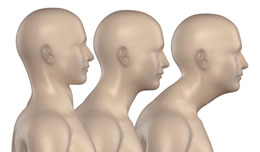The term 'kyphosis' refers to the normal outward curvature of the upper back or the thoracic spine. Abnormal curvature of the thoracic spine can give rise to a hunchback appearance. This write-up provides information on this condition.

The spine is divided into three sections: cervical (neck), thoracic (chest or upper back), and the lumbar spine (lower back). While the cervical and the lumbar spine have a lordotic curvature (normal inward curvature), the thoracic spine has a outward curvature. The normal outward curvature of the thoracic spine is medically referred to as kyphosis. The C-shaped kyphotic curve facilitates shock absorption and provides stability to the spine. Problems can arise when the curvature is beyond the normal parameters. While slight variations could be attributed to postural defects, abnormal curvature of this section of the spine might be caused due to certain degenerative disorders of the skeletal system.
Contributing Factors
☞ Postural kyphosis generally develops during adolescence. A slight change in the curvature might be seen in those who have a habit of slouching.
☞ An abnormal kyphotic curve could be present as a congenital defect. However, it is quite rare, and occurs when the vertebrae doesn't develop normally during the fetal stage.
☞ Scheuermann's kyphosis is another type that is attributed to a structural abnormality in the spine. It is first noticed during adolescence. It causes the body to bend forward. Traumatic injuries or disorders of the skeletal system could also cause an exaggerated kyphotic curve.
☞ Those affected by osteoporosis are at an increased risk of developing this condition. Reduced bone density could cause the vertebral bones in the spine to weaken, thereby making one susceptible to vertebral fracture.
☞ Neuromuscular disorders, spinal arthritis or degeneration of the discs could also be responsible for causing an abnormal kyphotic curve.
Symptoms
The symptoms could vary depending on the underlying cause. The common symptoms include:
☞ A change in the appearance of the upper back that restricts the range of motion
☞ Inability of the body to balance the weight
☞ Difficulty in standing upright
☞ Abnormal gait
☞ Back pain
☞ Musculoskeletal pain
☞ Muscle fatigue
☞ Tension headache
☞ Stiffness in the back
In severe cases, wherein the amount of space in the chest is limited, due to an abnormal curvature of the thoracic spine, the affected individual might even experience breathing problems.
Treatment
Besides a physical examination that includes study of spinal range of motion and postural inspection, certain orthopedic diagnostic tests, or imaging procedures could help doctors determine the most suitable treatment option. The use of anti-inflammatory drugs and back braces combined with physical therapy is generally recommended for the treatment of postural kyphosis. Performing certain exercises can surely help in correcting the posture. Degenerative diseases such as spinal arthritis or osteoporosis are some of the common causes of over-curvature of the upper back in adults, which is why treating these underlying conditions can also help prevent the bones from weakening further. If the forward curvature of the upper back is very conspicuous and is causing severe problems, surgery might be recommended for the correction of this structural abnormality.
If you feel that your spine has become rigid and your upper back is looking somewhat rounded, you must consult a doctor and try to correct your body posture. Timely treatment can surely prevent the spine from becoming abnormally curved or rounded.
Disclaimer:
The information provided in this article is solely for educating the reader. It is not intended to be a substitute for the advice of a medical expert.


 The spine is divided into three sections: cervical (neck), thoracic (chest or upper back), and the lumbar spine (lower back). While the cervical and the lumbar spine have a lordotic curvature (normal inward curvature), the thoracic spine has a outward curvature. The normal outward curvature of the thoracic spine is medically referred to as kyphosis. The C-shaped kyphotic curve facilitates shock absorption and provides stability to the spine. Problems can arise when the curvature is beyond the normal parameters. While slight variations could be attributed to postural defects, abnormal curvature of this section of the spine might be caused due to certain degenerative disorders of the skeletal system.
The spine is divided into three sections: cervical (neck), thoracic (chest or upper back), and the lumbar spine (lower back). While the cervical and the lumbar spine have a lordotic curvature (normal inward curvature), the thoracic spine has a outward curvature. The normal outward curvature of the thoracic spine is medically referred to as kyphosis. The C-shaped kyphotic curve facilitates shock absorption and provides stability to the spine. Problems can arise when the curvature is beyond the normal parameters. While slight variations could be attributed to postural defects, abnormal curvature of this section of the spine might be caused due to certain degenerative disorders of the skeletal system.